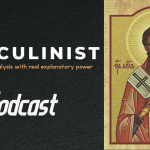This Article is from Masculinist #3
The Roots of the Feminization of Christianity
In 2004 David Murrow wrote a book about this called Why Men Hate Going to Church in which he surveyed the contemporary scene. His findings made for depressing reading.
Murrow is writing a typical popular audience book that derives most of its thinking from present-day church culture trends and uses a business school style of analysis. Leon Podles, who has a Ph.D., from the University of Virginia, took a more scholarly approach to the question in his 1999 book The Church Impotent: The Feminization of Christianity (free to read online in PDF format).
Podles agrees with Murrow on the state of current Christianity but adds some new dimensions. First, he argues that this female skew is specific to Western Christianity, saying that it has not affected the Eastern Orthodox Church. (I’m not convinced this is accurate). Secondly, he points out that this female skew is not new, but in fact, goes back hundreds of years to the High Middle Ages.
Starting in the 12th and 13th centuries, Podles says Western Christianity underwent a culture change that feminized it. He advances three main key driving causes, the popularization of “bridal mysticism” by St. Bernard of Clairvaux, a women’s movement in the church, and Scholasticism.
Bridal mysticism involved the use of highly erotic language to represent the individual believer as the bride of Christ, inspired by the Song of Solomon:
The use of erotic language to describe the relation of the believer to God was not unprecedented, but Bernard, for reasons that will become clear, did not choose to acknowledge his intellectual debts. Bernard claimed that “if a love relationship is the special and outstanding characteristic of bride and groom it is not unfitting to call the soul that loves God a bride.”… Having established the principle for the use of such language, Bernard then elaborated. He referred to himself as “a woman” and advised his monks to be “mothers”—to “let your bosoms expand with milk, not swell with passion”—to emphasize their paradoxical status and worldly weakness.
The women’s movement was a large 13th-century increase in the number of women flowing into religious orders, possibly resulting from a gender imbalance caused by an unusually high number of male deaths, and increasing freedom of travel for women due to widespread peace. The monasteries initially resisted having to instruct women in religious orders, but ultimately capitulated, in part because of Papal directives.
Scholasticism was a medieval intellectual movement that merged theology with classical philosophy, especially Aristotle. Thomas Aquinas is the paragon of the Scholastic type. Podles says that prior to Scholasticism, theology was the province of the monastery, where theological study was merged with religious practice as part of masculine daily devotional life. In the university, the home of the Scholastics, theology was a detached, rationalistic endeavor. The Scholastics may have been personally devout or even monks themselves, but their intellectual endeavors were in a “scientific” mode. Their work also resurrected Aristotelian notions about women that they interpreted as making women superior as to grace.
All of these threads continued to develop over time in ways that, per Podles, divorced Christianity from masculinity and attached it more and more to femininity and thus drove a female skew in church attendance.
Podles also points out that the men Christianity does attract are disproportionately low-masculinity “nice guy” types:
Because Christianity is now seen as a part of the sphere of life proper to women rather than to men, it sometimes attracts men whose own masculinity is somewhat doubtful. By this, I do not mean homosexuals, although a certain type of homosexual is included. Rather religion is seen as a safe field, a refuge from the challenges of life, and therefore attracts men who are fearful of making the break with the secure world of a childhood dominated by women. These are men who have problems following the path of masculine development.
Those attracted to the ministry were even more feminized, with academic research finding both Catholic and Protestant ministers rated as extremely feminine in contrast with other men.
I should point out that First Things ran a critical review of the book when it came out. I have some issues with this review, but it’s important to engage with critics. The upshot is that basically everyone agrees the church was skewed female in its attendance and orientation long before the modern-day, though there’s debate about exactly when and why this started.

